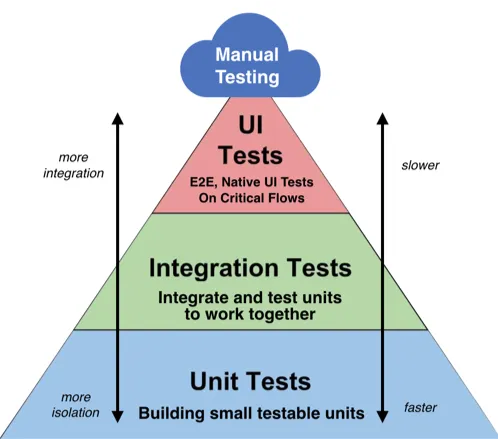Testing¶
Types of Testing¶

Unit Testing¶
- Testing specific isolated functions or classes in your code.
- Inputs are pre-defined and outputs are mocked to verify the code works as intended.
- Unit tests can be written for the backend (e.g. Pytest) and frontend (e.g. Vitest).
Integration Testing¶
- Verifies that different units or modules work together as expected.
- For example and endpoint on a web API can be tested as such:
- Call and endpoint that triggers code in various modules.
- Standarise the input to the test, for example a specific JSON.
- Check the output data matches the expected output, every time it runs.
- Typically backend tests, but can also be written to group together multiple frontend unit tests (for example, testing a component state).
End-to-End (E2E) Testing¶
- Similar to integration tests, except the entire expected user workflow is tested (i.e. the ordering is important).
- For example, if you expect a user to create a user account --> create a project --> perform some processing, then these steps will be tested in order (as if the user was using the software).
User Interface (UI) Testing¶
- Checking for changes to the user interface functionality can be automated.
- As of 2024, a great tool to do this is Playwright.
- The idea is to navigate to various pages and see if the output is as expected.
- For example, a screenshot of a page can be taken on a page load, then compared against a page load in a future test. This will determine if any unexpected visual regression has occured.
- Page elements can be navigated and interacted with using various properties, such as element names, ids, labels, to lower level CSS and XPath if required.
Performance Testing¶
- Evaluates the system's responsiveness, scalability, and stability under different conditions.
- Includes:
- Load testing, for expected and peak load.
- Stress testing, for abnormally high load / upper limit testing.
- Scalability testing, used to identify optimal configuration to handle load.
- Generally for backend or database code.
- An example could be using a profiler to determine response time in a web API,
or using
EXPLAIN ANALYSEon a database to determine bottlenecks.
Security Testing¶
- Identifies Common Vulnerabilities and Exposures (CVEs) in software.
- CVEs are publically available lists of identified security flaws in code.
- One way to test this could be container image scanning, which checks for vulnerabilities in the underlying operating system, plus the code and dependencies.
Smoke Testing¶
- A test to pretty much see if your application starts up.
- If a smoke test fails, then you application failed to initialise.
- Particularly useful to test if a container runs as expected.
- Useful to include in CI to prevent deployment if smoke test fails.
Testing Terminology¶
White Box Testing¶
- Examines the internal logic, code structure, and implementation details of the software.
- Requires knowledge of the internal workings of the application.
Black Box Testing¶
- Tests the software's functionality without knowing its internal code or logic.
- Focuses on inputs and outputs, treating the software as a "black box".
Alpha Testing¶
- Conducted by a select group of users before the software's public release.
- Focuses on identifying major issues before wider deployment.
Beta Testing¶
- Conducted by a larger group of users in a real-world environment.
- Gathers feedback from end-users to improve the software before the final release.
Python¶
PyTest¶
- PyTest is a popular unit testing framework for Python, with more
in-built functionality than the standard Python
unittestmodule. - It has a simple and concise syntax, many plugins, plus async support, and detailed / informative reporting.
- Two major advantages are:
- Fixtures: allows you to set up and tear down resources during testing, for example database entries.
- Parameterised testing: allowing you to run the same test with different input values.
- With the help of plugins, it's easy to write integration tests too.
- For example a FastAPI endpoint can be called with inputs, to test the outputs are as expected.
Usage:
pytest
Coverage¶
- The concept of coverage is to determine the amount of your code that is executed during unit tests.
- This metric is a rough approximation of how thoroughly your tests actually test your code.
- Use with care, this is only an assessment of how much code is touched by your tests. A 100% coverage codebase may still be poorly tested.
Usage:
coverage run -m pytest
Generating reports:
coverage report -m